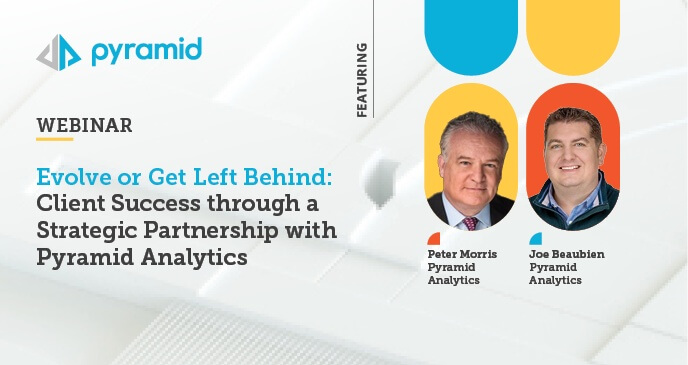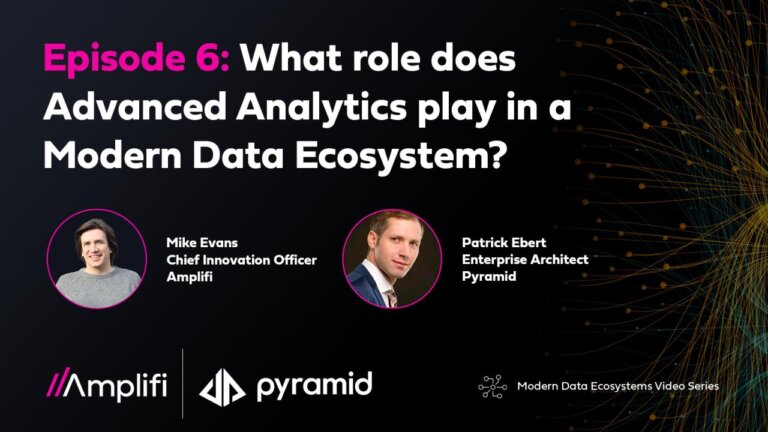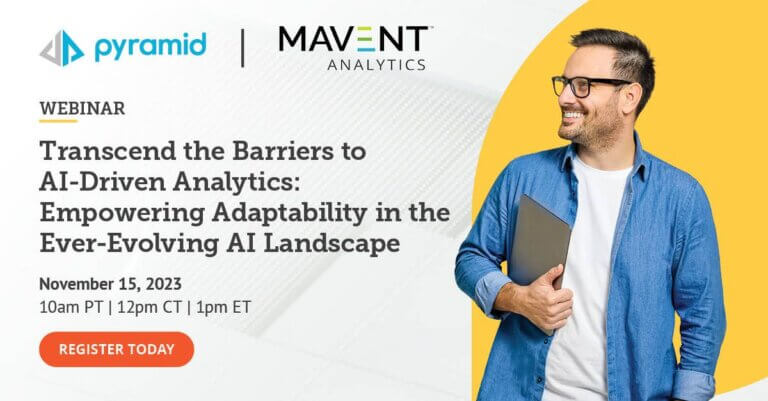Mike Vizard: Hello and welcome to the latest edition of the Digital CxO Leadership Insights series video. I’m your host Mike Vizard. Today we are with Omri Kohl who’s the CEO for Pyramid Analytics. We’ll be talking about decision intelligence. Omri, welcome to the show.
Omri Kohl: Thank you, Mike. It’s great to be here. Thank you for inviting me.
Mike Vizard: What do we mean by decision intelligence these days? Because you know, we’ve had business intelligence for years and of course, you know, I’m old enough to realize that anything with the word “intelligence” in it might be an oxymoron. So, what exactly are we talking about?
Omri Kohl: That’s a great observation. So, as you described actually, BI was probably the most known part of data analytics over the last few decades. Things have evolved; organizations grew as data-driven organizations. In the most — I would say — recent part of the last decade, the incorporation of data preparation and leveraging data assists, BI as everyone knows it (or data discovery), also data science and machine learning (what is referred to as AI) is a big part of decision intelligence. So, basically taking the three disciplines or the three practices and combining them together.
Mike Vizard: What exactly drives people to make this level of investment these days because, you know, BI has always been kind of off in the periphery a little bit. People are still using their spreadsheets. We talk a lot about the need to make better decisions faster but at some point, when you talk to your customers, what is the thing that gets the C-level guys to go, “Yeah, we got to go in and invest in this,” because it’s always been an interesting theory but in practice, I don’t know, they’re a little suspect sometimes?
Omri Kohl: Yeah, so, in data, we’re talking about the three V’s; velocity, variety, and volume. When the three of those increase dramatically — we use to talk about big data and investment in big data — it basically means that the three V’s have increased dramatically and organizations at some point stop making or stop taking advantage of the massive data that they can use. When organizations realize that in order to become more and more data-driven and make use of those three V’s, they need a bigger platform, a bigger approach.
If you think about use cases in banking, insurance, and retail, it’s the ability to take advantage of the competition when it comes to your supply chain, when it comes to risk assessment for insurance, and when it comes to credit lines with banking. It’s not just a single simple use-case of, “Can I sell more products at this certain price?” But actually having a more holistic approach, cross-function, and cross-department for a certain use-case.
Mike Vizard: Do you think we’re getting to the point soon where we need to make decisions faster than humans are capable on their own because I just can’t analyze all the data and make the appropriate response in time to take advantage of the moment, transaction, or whatever is happening in real-time?
Omri Kohl: So, first of all, yes. I think the simple answer is we as humans can only look at a certain of data or certain places that data is residing in. Machines can do things faster — maybe smarter — than we can assume that they learn themselves certain data assets. I think eventually AI or machine learning can help us, at least, get to the point where we make better decisions faster and smarter.
Mike Vizard: A lot of senior-level executives especially don’t always trust the data and with good reason. A lot of the data has been entered, it’s incorrect, sometimes there’s missing context, and sometimes it just flat-out conflicts with each other. So, how do we get to a point where as an IT leader, I can come to the C-level execs and say, “Yes, you can finally trust the application of the data”? Because, for the most part, data management has been a mess for the better part of three or four decades now.
Omri Kohl: It’s true. You know, it’s always been said, “garbage in, garbage out.” So, if people eventually look at dirty data or inaccurate data, it’s a huge problem. When you talk about the decision intelligence platform, we tend to include the data cleansing part as part of the whole approach. I think today, organizations are doing a much, much better job in refining the data that they look in. There is a bigger — I would say — or a larger discipline around data insertion but also data cleansing.
So, I think it probably would be fair to say that in the last few decades, this has been improving gradually and I think today we’re in a point where organizations realize that data is mission-critical and when it’s mission-critical, organizations invest a lot of time, money, and energy into making sure that what they’re looking at from a data perspective is actually accurate. Are there still challenges with data? Yes, there are. This is, again, where machine learning, or automation, or AI — choose the word that suits the best — but automation around data cleansing is a huge part of making sure that decisions through decision-intelligence platforms are being trusted.
Mike Vizard: How smart will all this get? I mean, in my ideal world, I’d like to be able to do what-if simulations on certain decisions that I might take and maybe there’s a confidence score that says, “Yep. That one’s absolutely going to get you fired. That one has a 50 percent probability of getting — and this one is a safe bet.” Is that where we’re headed? Or, how far can we go?
Omri Kohl: You know, we’re talking about self-driving cars for, I don’t know, two decades now? How far is that away from being a reality? It’s a good question. Self-driving organizations, if you will, I think they’re still pretty far away but we’re getting much better at helping humans make better decisions with data. So, I think the idea is to give you alternatives very fast, very quickly, from all the data that is available for you as an employee in an organization or decision maker starting from the C-suite down to anybody else in the convention, if you will, of the organizations.
So, I think there are areas where automation or AI is already taken decisions — you know, in production lines, when you look at — we talked about cars — so cars production and quality assurance is happening with robots. It is driven by data. Which part should be where and how accurate the screw needs to be? All of that is eventually driven by data.
So, there are areas where it’s happening already. I think that what you’re referring to, are we going to replace our gut instinct (which is what usually drove decisions with data). I think this is a human behavior that I think will need to change. I think that the systems are probably almost there to help us make those decisions if we trust the data and we want to make data-driven decisions. It’s about changing human behavior. I think this is the tricky part.
Mike Vizard: To that point, a lot of the gut instinct decisions, it’s very hard to distinguish what is your level of experience talking to you and perhaps what indigestion you might have had from lunch; right? It’s not quite clear. And sometimes people will make different decisions on different days based on what they had for lunch. So, how do we take that kind of less-than-scientific factor out of the decision-making process?
Omri Kohl: Yeah, I mean, you’re absolutely right. Decision-making is a mix of science and art. We still need to hire capable, experienced, smart people for certain jobs despite the fact that I can give you a data-driven answer on most of the things that you need to act upon in your organization. So, I think that probably data is still a supporting tool for making decisions but with the decision-intelligence approach, the support is much stronger.
So, to your earlier point on the accuracy of data, this is where automation or AI comes into play around the data cleansing. When it comes to giving you a narrative before you make a decision, what happened over the last — whatever — a few months in your credit assessment of the stock market and where you should be heading? Again, this is where AI can help you at least realize the reality much better and clean the emotional part of your indigestion from lunch.
Mike Vizard: You guys just raised a large amount of capital. What are the plans for that? Where are you guys going next?
Omri Kohl: Yeah, so we did announce our recent finding round; we raised $120 million. In the last two years, we’ve been experiencing a very exponential growth I think because of all the things we talked about. Organizations are moving to become much more data-driven and because of that, they need to lean on better platforms and a more holistic approach inside their organizations in order to influence that decision-making approach. We’re going to increase our go-to-market presence heavily. The category of decision intelligence is not really that defined. You mentioned at the beginning that there is BI and there are data management and maybe ETL or data preparations. So, we are looking to define the data intelligence category and definitely lead it. I think we have a very mature offering in the market today and it’s all about making sure that people actually know about it and start using it.
Mike Vizard: What’s the one thing you wish organizations were doing before they engage with you and kind of made it easier to get to the end result? Are there things that you wish organizations were more prepared for or just simply better understood before they went down this path?
Omri Kohl: I think that the most important part is realizing the pain that they’re facing. Organizations invest today a lot of money in trying to get their hand so data and trying to use disparate systems. Data is a mission-critical application but unfortunately, it’s not a standard platform in organizations. Usually, you have a single CRM system, you have a single ERP system, but then you have sometimes hundreds of BI or analytics initiatives. The more you standardize on your analytics solution, the more data-driven you are. So, I think realizing the pain and understanding how much they can actually improve as an organization, return on investment on your analytics platform, better service, more revenues, better production lines, and better access to the market. All of those pains are things that when you actually realize that you can improve on, you can definitely make a change using Pyramid.
Mike Vizard: Do you think we spend too much time on the backend on this whole effort with the data warehouse and people want to build data lakes and sometimes the lakes turn into swamps and all kinds of crazy things are happening? But, I mean, basically, all those are backend repositories. So, maybe, we don’t have enough focus on the front end.
Omri Kohl: First of all, I think that it’s not mutually exclusive. You need to continue to work on the back end. It is true that data assets and data states are changing. They’re moving from — as you said — from enterprise data warehouses to data lakes, from data lakes to lake houses, from on-prem to cloud, and that’s a natural progression of technology. So, I think that makes sense. What needs to, or the practice that organizations should never neglect is the way they collect the data and make it accessible for their internal and external users. This is where I think today’s decision-intelligence as a platform can help do a much better job actually leveraging the investment that you continue to do on the backend.
Mike Vizard: All right. Hey, Omri, thanks for being on the show and sharing your insights.
Omri Kohl: Thank you, Mike, it’s been a pleasure to be here.
Mike Vizard: All right. Thank you all for once again watching this latest episode of the Digital CxO Leadership Insights series. You can find this podcast and videocasts like it on digitalcxo.com. We invite you to check out the website. Once again, thank you all for spending some time with us.





